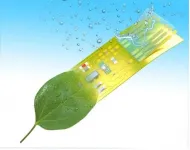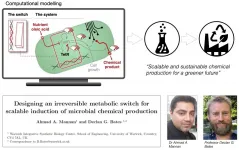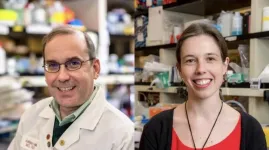Discovery of the oldest plant fossils on the African continent!
A new study describes a particularly diverse fossil flora from 400 million year ago.
2021-06-08
(Press-News.org) The analysis of very old plant fossils discovered in South Africa and dating from the Lower Devonian period documents the transition from barren continents to the green planet we know today. Cyrille Prestianni, a palaeobotanist at the EDDy Lab at the University of Liège (Belgium), participated in this study, the results of which have just been published in the journal Scientific Reports.
The greening of continents - or terrestrialisation - is undoubtedly one of the most important processes that our planet has undergone. For most of the Earth's history, the continents were devoid of macroscopic life, but from the Ordovician period (480 million years ago) green algae gradually adapted to life outside the aquatic environment. The conquest of land by plants was a very long process during which plants gradually acquired the ability to stand upright, breathe in the air or disperse their spores. Plant fossils that document these key transitions are very rare. In 2015, during the expansion of the Mpofu Dam (South Africa), researchers discovered numerous plant fossils in geological strata dated to the Lower Devonian (420 - 410 million years ago), making this a truly exceptional discovery.
Cyrille Prestianni, a palaeobotanist at the EDDy Lab (Evolution and Diversity Dynamics Lab) at the University of Liège, explains: "The discovery quickly proved to be extraordinary, since we are in the presence of the oldest fossil flora in Africa and it is very diversified and of exceptional quality. It is thanks to a collaboration between the University of Liège, the IRSNB (Royal Belgian Institute of Natural Sciences) and the New Albany Museum (South Africa) that this incredible discovery could be studied. The study, which has just been published in the journal Scientific Reports, describes this particularly diverse fossil flora with no less than fifteen species analysed, three of which are new to science. Dr. Prestianni adds : « This flora is also particularly interesting because of the quantity of complete specimens that have been discovered," says the researcher. These plants are small, with the largest specimens not exceeding 10 cm in height. They are simple plants, consisting of axes that divide two or three times and end in reproductive structures called sporangia. »
The fossil flora of Mpofu allows us today to imagine what the world might have been like when the largest plants were no taller than our ankle and almost no animals had yet been able to free themselves from the aquatic environment. It gives us a better understanding of how our Earth went from a red rock devoid of life to the green planet we know today. These plants, simple as they are, are a crucial step in the construction of the environments that hosted the first land animals, arthropods. They form the basis of the long history of life on Earth, which continues today from dense tropical forests to the arid tundra of the north.
INFORMATION:
[Attachments] See images for this press release:

ELSE PRESS RELEASES FROM THIS DATE:
2021-06-08
CAMBRIDGE, Mass.--(BUSINESS WIRE)--QurAlis Corporation, a biotech company developing breakthrough precision medicines for ALS and other genetically validated neurodegenerative diseases, today announced the publication of an article in Cell Reports titled Human Amyotrophic Lateral Sclerosis Excitability Phenotype Screen: Target Discovery and Validation by QurAlis founders Kasper Roet, Ph.D., Clifford Woolf, M.D., Ph.D., and Kevin Eggan, Ph.D., who pioneered a high-content, live-cell imaging screen using ALS patient-derived motor neurons in combination with a compound library generated by Pfizer to identify drug targets to treat hyperexcitability induced neurodegeneration ...
2021-06-08
A research team from the University of Massachusetts Amherst has created an electronic microsystem that can intelligently respond to information inputs without any external energy input, much like a self-autonomous living organism. The microsystem is constructed from a novel type of electronics that can process ultralow electronic signals and incorporates a device that can generate electricity "out of thin air" from the ambient environment.
The groundbreaking research was published June 7 in the journal Nature Communications.
Jun Yao, an assistant professor in the electrical and computer engineering (ECE) and an adjunct professor in biomedical engineering, ...
2021-06-08
DURHAM, N.C. - Using drones and artificial intelligence to monitor large colonies of seabirds can be as effective as traditional on-the-ground methods, while reducing costs, labor and the risk of human error, a new study finds.
Scientists at Duke University and the Wildlife Conservation Society (WCS) used a deep-learning algorithm--a form of artificial intelligence--to analyze more than 10,000 drone images of mixed colonies of seabirds in the Falkland Islands off Argentina's coast.
The Falklands, also known as the Malvinas, are home to the world's largest colonies of black-browed albatrosses (Thalassarche melanophris) and second-largest ...
2021-06-08
Researchers from the University of Liège (Belgium) have recently developed a new artificial neuron inspired by the different modes of operation of human neurons. Called a Bistable Recurrent Cell (BRC), this process has enabled recurrent networks to learn temporal relationships of more than a thousand discrete time units where classical methods failed after only a hundred time units. These important results are published in the journal PLOS One.
The enormous interest in artificial intelligence (AI) in recent years has led to the development of extremely powerful machine learning techniques. For example, time series - any series of data where a time component is ...
2021-06-08
The speed of water flow is a limiting factor in many membrane-based industrial processes, including desalination, molecular separation and osmotic power generation.
Researchers at The University of Manchester's National Graphene Institute (NGI) have published a study in Nature Communications showing a dramatic decrease in friction when water is passed through nanoscale capillaries made of graphene, whereas those with hexagonal boron nitride (hBN) - which has a similar surface topography and crystal structure as graphene - display high friction.
The team also demonstrated that water velocity could be selectively controlled by covering the high friction hBN channels with graphene, opening ...
2021-06-08
DURHAM, N.H.--Why did the deer cross the road? According to research from the University of New Hampshire to keep going and going and going. Researchers have discovered the longest distance ever recorded by an adult male white-tailed deer--300 kilometers, or close to 200 miles, in just over three weeks. The finding has important implications for population management and the transmission of disease, especially chronic wasting disease, a fatal neurological disease.
"Deer are one of the most abundant, well-known and intensely managed species of wildlife in the United States," said Remington Moll, assistant ...
2021-06-08
The bad odors produced by the Waste Water Treatment Plants, known as WWTPs, have become a growing concern in the cities and towns that host these facilities and are considered by citizens to be the main cause of the perception of pollution, along with the dust and noise.
Now, and thanks to a collaboration between the Institute for Bioengineering of Catalonia (IBEC) and the company DAM, a new way is being opened to detect and treat these odors.
According to the researchers, "the results obtained in the SNIFFDRONE project (Odor monitoring by drones for environmental purposes) are very positive and represent a significant advance ...
2021-06-08
- Most high-value chemicals are currently produced using fossil fuels - industrial chemistry's use of petroleum accounts for 14% of all greenhouse gas emissions.
- An exciting alternative is to engineer bacteria as "cell-factories" with a genetic switch that reroutes their chemistry to produce high-value chemicals, such as biofuels, polymers and pharmaceuticals.
- The use of expensive chemicals to switch them on severely limits their commercial potential, researchers have used mathematical models to develop a new genetic switch that can use a cheap natural ...
2021-06-08
JUNE 8, 2021, NEW YORK - A study conducted by researchers at the Ludwig Center at Harvard has demonstrated how a drug screening method known as dynamic BH3 profiling can be used to quickly identify potentially effective combinations of existing drugs for personalized cancer therapy.
"We know that cancer cells and healthy cells have different metabolisms," said Ludwig Harvard investigator Anthony Letai who, with former postdoctoral researcher Veerle Daniels, led the study reported in the current issue of Science Signaling. "Using BH3 profiling, we found a specific metabolic dependency in triple ...
2021-06-08
Published monthly, the journal CHEST® features peer-reviewed, cutting-edge original research in chest medicine: Pulmonary, critical care, sleep medicine and related disciplines. Journal topics include asthma, chest infections, COPD, critical care, diffuse lung disease, education and clinical practice, pulmonology and cardiology, sleep and thoracic oncology.
The June issue of CHEST includes 95 articles, clinically relevant research, reviews, case series, commentary and more. Each month, the journal also offers END ...
LAST 30 PRESS RELEASES:
[Press-News.org] Discovery of the oldest plant fossils on the African continent!
A new study describes a particularly diverse fossil flora from 400 million year ago.







